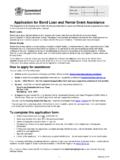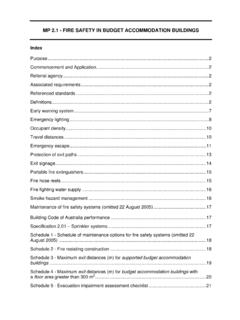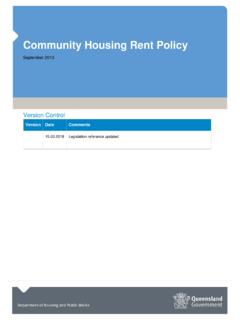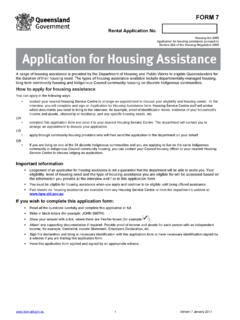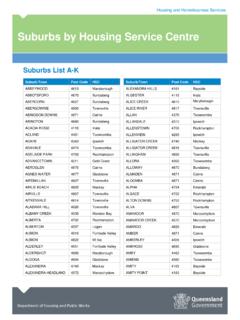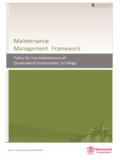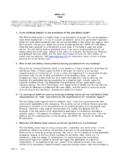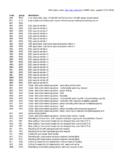Transcription of A guideline for the use, inspection and maintenance of ...
1 Deck, balcony and window safety A guideline for the use, inspection and maintenance of decks, balconies and windows March 2017 Deck, balcony and window safety: guideline Building Industry and Policy March 2017 Page 2 of 21 Table of Contents Table of Contents .. 2 Why this guideline ? .. 3 What standards apply? .. 3 Coroner Reports 4 2010 Coroner s report into deck collapse 4 2012 Coroner s report into accident on a damaged deck 4 1. Decks and balconies .. 6 Balustrade requirements 6 Stairs 7 Windows 7 2. Safety .. 8 Children 8 Adults 10 3. maintenance issues to consider .. 11 Termite attack 11 Decay and moisture 11 12 Coastal effects 13 Loads 13 4. Inspecting decks and balconies .. 14 Components of decks and balustrades to regularly inspect 14 14 15 Check bearers and joists for warping or cracking 16 16 Planning on extending, renovating or 18 Contacts for advice and/or inspection services.
2 18 Acknowledgements .. 19 Glossary .. 19 Deck, balcony and window safety: guideline Building Industry and Policy March 2017 Page 3 of 21 Why this guideline ? This guideline has been developed to help building owners and occupiers, builders and inspectors carry out inspections on balustrades, decks and balconies in order to check the safety of these structures. The guideline may be useful for industry professionals. However, the information is not a replacement for technical standards used by industry. Owners and managers of non-residential buildings with a deck or balcony, such as restaurants, hotels and clubs, may also find this guideline relevant. The guideline also provides useful advice about safety issues associated with elevated floors and openable windows.
3 In recent years a number of deaths and serious injuries have occurred as a result of falls from decks, balconies and windows, or from the collapse of decks and balconies. Statistics from pre-purchase inspection agencies suggest that approximately six per cent of Australian houses have a timber deck or balcony and about two per cent of these may cause potentially fatal injuries if they collapsed or if the balustrade or railing failed. These numbers are estimated to be even higher in Queensland where, due to our unique climate, timber decks are a major feature of many homes. Some of these decks may have been constructed inadequately or illegally and could now be in danger of collapse. Building owners especially need to consider risks and consequences arising from an injury or death associated with a failing balustrade or deck, which is shown to be in poor condition or illegally built.
4 If you own a building with a balcony or deck whether it is made from timber, metal, concrete or another material you should ensure it is inspected carefully for decaying timbers, unstable balustrades, corrosion and cracking of concrete. What standards apply? The National Construction code (NCC) provides the requirements for new building work throughout Australia. Unless new building work is occurring, a building is only required to meet the standards in force at the time of the most recent building approval. The building standards mentioned in this guideline are from the current NCC and apply to new building work. Existing buildings that are the subject of additions, alterations or renovations may also be required to meet the NCC provisions.
5 Remember In Queensland between 2002 and 2012 more than 20 people have died and hundreds have been injured after falling from decks or balconies. A small but significant proportion of cases have been associated with structural failure of the deck or balcony. Had people been more aware of the dangers associated with elevated areas and the importance of adequate maintenance of decks and balconies, some of these deaths and injuries may have been prevented. Adequate maintenance of decks and balconies can save lives Deck, balcony and window safety: guideline Building Industry and Policy March 2017 Page 4 of 21 Coroner Reports 2010 Coroner s report into deck collapse In June 2010, the Brisbane Coroner released findings from an investigation into a death caused by a deck collapse.
6 The deck was constructed prior to the 1940s using methods that are not common by today s standards. The Coroner recommended occupiers of all residential dwellings that include a timber deck or balcony (particularly those built before the 1940s) have them checked for structural integrity. Figure 1 shows a typical construction method for pre-1940s decks. The beam (or bearer) is cogged out to hold the joist. The joist is held in place with nails. This was the joining method used on the collapsed deck. In this type of construction method, the ends of the joists are concealed by the bearer in the area where the joist rests. Over time, the nails can rust out, the beam can bow outwards and the joist can separate, potentially resulting in structure failure or collapse as shown in Figure 2.
7 It is important to note that this is just one way in which a deck may fail. Other areas should be inspected on a regular basis to check the structure s reliability and integrity. Figure 1: Pre-1940s deck construction with a cogged out beam holding the joist with nails. Figure 2: Old nails can rust out causing structure to collapse Deck, balcony and window safety: guideline Building Industry and Policy March 2017 Page 5 of 21 2012 Coroner s report into accident on a damaged deck In September 2012, the Rockhampton Coroner released findings from an investigation into a death caused by a decayed decking board. The Coroner recommended that State agencies provide guidance about the inspection of decking boards for signs of deterioration that may compromise their structural integrity.
8 The coroner further recommended that Standards Australia design an Australian Standard to establish how deck inspections should be conducted. One of the decayed decking boards from the accident. Deck, balcony and window safety: guideline Building Industry and Policy March 2017 Page 6 of 21 1. Decks and balconies Balustrade requirements In Queensland there are strict requirements for the design and construction of balustrades and railings. Under the NCC, a balustrade or barrier is required where people could fall one metre or more from a floor or accessible roof of a building. Put simply, where a difference in height from the deck or balcony to the ground or another lower level is one metre or more, a balustrade of at least one metre in height is required.
9 Retaining walls do not require a balustrade unless they are associated with a path of travel to, from or between buildings. However, for other retaining walls, it is a good idea to provide a balustrade or other barrier in situations where there is a risk of a person falling from the retaining wall. Requirements for balustrades differ depending on the height of the deck or balcony above the ground. For decks or balconies more than one metre above the ground, a balustrade cannot have any openings greater than 125 millimetres, to help prevent people from falling through them. This is also a requirement for decorative balustrades. For decks or balconies more than four metres above the ground, a balustrade must also not have any climbable elements, such as horizontal rails, located between 150 millimetres and 760 millimetres from the floor.
10 Balustrades must be constructed so that they can resist the forces reasonably expected to be placed upon them. These forces include people leaning against them and strong winds. Figure 3: Balustrade or other barrier construction (Courtesy: Australian Building Codes Board). Remember Where a deck or balcony is one metre or higher above the ground, balustrades need to be at least one metre high. For decks more than one metre above the ground, openings in balustrades, including decorative balustrades, cannot be greater than 125 millimetres. For decks more than four metres above the ground, balustrades cannot have any climbable elements located between 150 millimetres and 760 millimetres from the floor.

